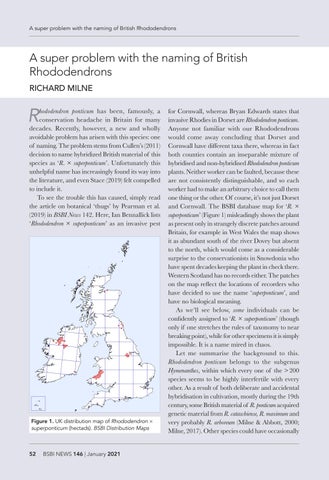A super problem with the naming of British Rhododendrons
A super problem with the naming of British Rhododendrons RICHARD MILNE
R
hododendron ponticum has been, famously, a conservation headache in Britain for many decades. Recently, however, a new and wholly avoidable problem has arisen with this species: one of naming. The problem stems from Cullen’s (2011) decision to name hybridized British material of this species as ‘R. × superponticum’. Unfortunately this unhelpful name has increasingly found its way into the literature, and even Stace (2019) felt compelled to include it. To see the trouble this has caused, simply read the article on botanical ‘thugs’ by Pearman et al. (2019) in BSBI News 142. Here, Ian Bennallick lists ‘Rhododendron × superponticum’ as an invasive pest
© BSBI 2021
Figure 1. UK distribution map of Rhododendron × superponticum (hectads). BSBI Distribution Maps
52
BSBI NEWS 146 | January 2021
for Cornwall, whereas Bryan Edwards states that invasive Rhodies in Dorset are Rhododendron ponticum. Anyone not familiar with our Rhododendrons would come away concluding that Dorset and Cornwall have different taxa there, whereas in fact both counties contain an inseparable mixture of hybridised and non-hybridised Rhododendron ponticum plants. Neither worker can be faulted, because these are not consistently distinguishable, and so each worker had to make an arbitrary choice to call them one thing or the other. Of course, it’s not just Dorset and Cornwall. The BSBI database map for ‘R. × superponticum’ (Figure 1) misleadingly shows the plant as present only in strangely discrete patches around Britain, for example in West Wales the map shows it as abundant south of the river Dovey but absent to the north, which would come as a considerable surprise to the conservationists in Snowdonia who have spent decades keeping the plant in check there. Western Scotland has no records either. The patches on the map reflect the locations of recorders who have decided to use the name ‘superponticum’, and have no biological meaning. As we’ll see below, some individuals can be confidently assigned to ‘R. × superponticum’ (though only if one stretches the rules of taxonomy to near breaking point), while for other specimens it is simply impossible. It is a name mired in chaos. Let me summarise the background to this. Rhododendron ponticum belongs to the subgenus Hymenanthes, within which every one of the > 200 species seems to be highly interfertile with every other. As a result of both deliberate and accidental hybridisation in cultivation, mostly during the 19th century, some British material of R. ponticum acquired genetic material from R. catawbiense, R. maximum and very probably R. arboreum (Milne & Abbott, 2000; Milne, 2017). Other species could have occasionally
















